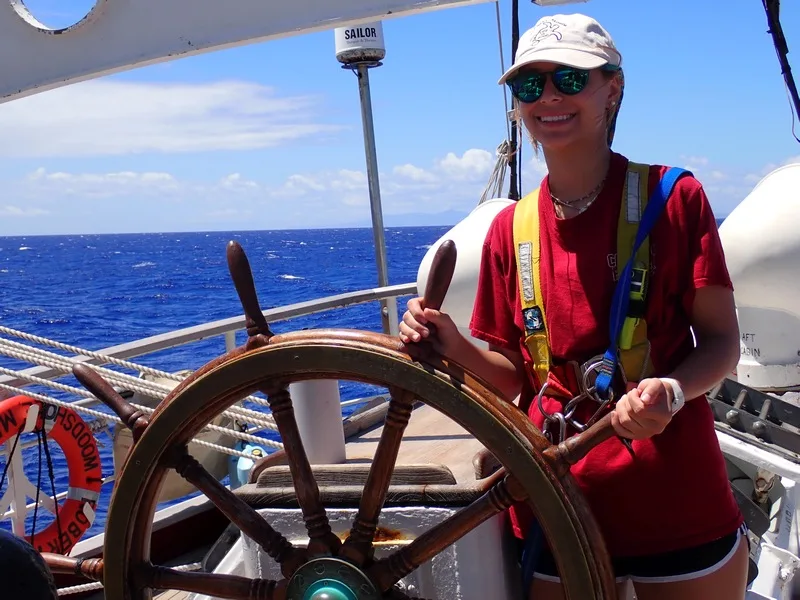Programs Blog
Thrills and Transformations on the High Seas

June 29, 2o23
Olivia Patrinicola, University of South Carolina
Ship’s Log
Location
18° 24.5′ N x 160° 34.5 W, ~220 nm southwest of Oahu (our nearestpoint of land)
Weather:
Sunny and clear, Wind-NE, Beaufort force 4
Every day is filled with new information and crazy experiences. I am not sure when I will be less surprised by all the new tasks and sights to be seen, but they sure are all very exciting. Although everything is so different, it feels like a routine is finally being established. The students (including myself) have spent the past two days now at sea, “learning the ropes”. I cannot say that I know what I am doing just yet, but ever so slowly confidence is building. As someone who has never been out at sea and definitely has never sailed a ship, it all feels like a whole other world. The vessel is like a miniature village. The boobies-small birds who love to catch flying fish and dive deep into the water-are the pesky little children who only cause mischief all day long. This is not even a joke. The boobies (red footed, Sula sula) sit on the masts, poop on the deck (and occasionally a person), and dive for flying fish. Of course we still welcome the stealthy and swift little birds as they embark on our journey with us. Everything on the boat is different than it is on land. The trash gets collected differently, showers and bathroom usage is different, and even the way one foot lands in front of the other is different when traveling across the ship.
Every twelve hours, all of the students, deckhands, and mates gather in their designated watch groups (go B watch!) and watch times, and conduct their operation of the boat for six hours while the rest of the ship is off duty. Some of the tasks include managing the sails, conducting boat checks, recording weather patterns, standing on lookout on the bow, manning the helm, assisting in the laboratory, and using spare time to learn any morsel of information that may come by. I enjoy lookout, although I have not had the opportunity to conduct lab work just yet. Watching the horizon as the boat trucks along is peaceful and has been an amazing time to reflect on the journey and become an all-star song-writer and singer. The image attached to this blog post was from my watch group’s post-watch meeting. We use the time to share how the watch went with our fellow team members. I was sharing with the team that my sea sickness has officially subsided.
We have class every weekday at 1430. Today was particularly exciting because the scientists on board launched the neuston net for the first time. The neuston net is a fine mesh net that gets towed off the side of the boat at surface level. The net funnels down into a small plastic cup that catches any fun critters that did not make it past the fine mesh. The boat moves at two nautical miles and the net is deployed for thirty minutes. When the net is collected, the cup at the end of the net holds fun goodies such as zooplankton and tiny fish that are further examined and analyzed. Today they caught a blue bottle, which is a siphonophore that can float on the surface of the water and catch small phytoplankton. It gets its name because of its small size and strikingly blue hue.
My name is Olivia Patrinicola, and I am a student here on the Robert C. Seamans. I go to the University of South Carolina (go Gamecocks!) and I study Marine Science. I decided to embark on this journey extremely last minute, about a month before the start date, so everything has started so quickly. I am very happy I decided to do this and cannot wait to see what I learn when I make it to the lab. Hello Mom and Dad. I am well, and I miss you a lot. Shout-out to Frankie and my friends from home, I hope you all are having a great summer. Lastly, hey Will, I hope your adventures on the Westcoast are serving you well. Love and miss you all!
 Olivia with “B Watch” debriefing after their six-hour shift
Olivia with “B Watch” debriefing after their six-hour shift
Recent Posts from the Ships
- Ocean Classroom 2024-A collaborative high school program with Proctor Academy
- Collaborations and Long-term Commitments: SEA’s Caribbean Reef Program Sets a Course for Coastal Programs that Compliment Shipboard Experiences.
- Sea Education Association students prepare for life underway using state of the art nautical simulation from Wartsila Corporation.
- SEA Writer 2022, Magazines From the Summer SEA Quest Students
- Technology@SEA: Upgrades Allow Insight into Ocean Depths
Programs
- Gap Year
- Ocean Exploration
- High School
- Science at SEA
- SEA Expedition
- SEAScape
- Pre-College
- Proctor Ocean Classroom
- Protecting the Phoenix Islands
- SPICE
- Stanford@SEA
- Undergraduate
- Climate and Society
- Climate Change and Coastal Resilience
- Coral Reef Conservation
- Marine Biodiversity and Conservation
- MBL
- Ocean Exploration: Plastics
- Ocean Policy: Marine Protected Areas
- Oceans and Climate
- Pacific Reef Expedition
- The Global Ocean: Hawai'i
- The Global Ocean: New Zealand